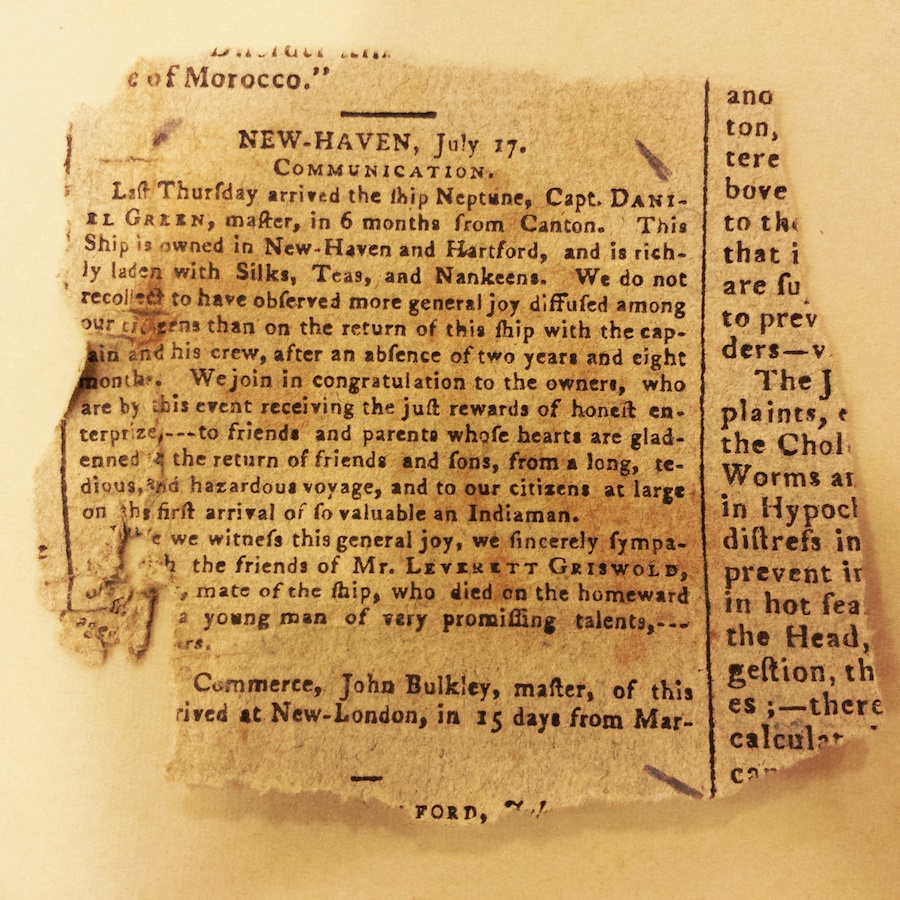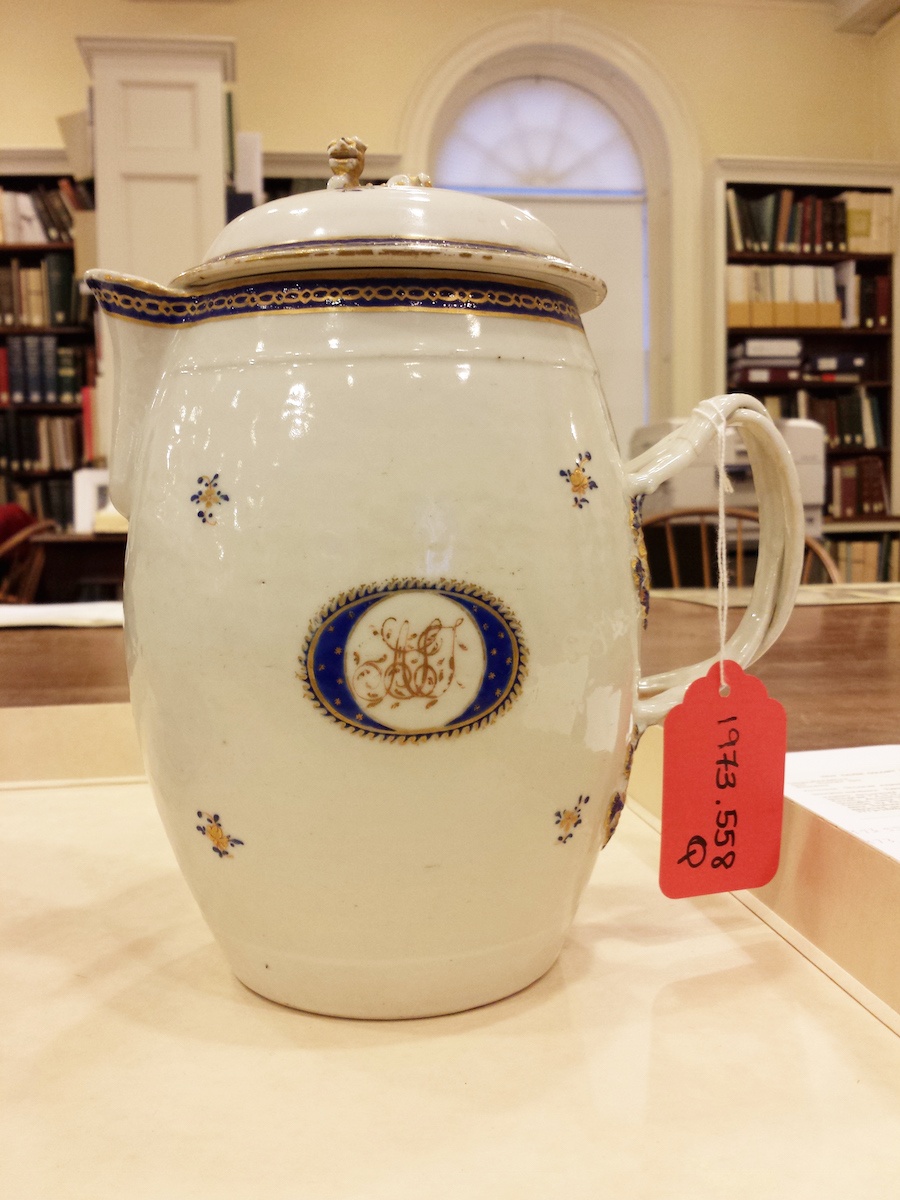
On July 11, 1799 the 350-ton merchantman Neptune pulled into Long Wharf with a cargo of Chinese teas, silks, lacquerware, and export porcelain valued at over $280,000. No other sailing vessel of the period would make as much money on a single trip as did this one, constructed at the old Olive Street shipyards and captained by Water Street resident Daniel Greene.
It was, by all accounts, a sight to behold. A large, sturdy ship, with $75,000 worth in duties. At the time, that was $20,000 more than the state’s civil list tax, according to an op-ed in The Connecticut Journal. In the same article, the writer asked: “On reflection, is it not a fact of importance that a single ship should pay more taxes than the whole taxable property of Connecticut?”

It was a question then that may still resonate now—as museum-goers usher in the Chinese or Lunar New Year (it is the Year of the Dog) later this week. Samples of the cargo’s hand-decorated china now belong to the Whitney Library and New Haven Museum (NHM), and some will be on display during Lunarfest 2018 this coming Saturday.
The day-long Lunarfest event typically consists of a parade and dragon dance down Whitney Avenue, followed by an afternoon of cultural programs at the museum, at the Yale-China Association, and at Luce Hall.
This year’s theme is “People to People,” underscoring the commonalities among community members instead of focusing on their differences.
Bringing in the Neptune’s history amidst calligraphy classes, lantern-making and tai-chi resonates with the theme, said NHM Director of Education and Visitor Experience Amy Durbin.
“We’re trying to tie in objects from our collection,” she said in a recent interview. “As part of that, we figured we’d activate part of New Haven’s maritime history.”
During Lunarfest, the museum takes on children and family programming, working with close to 500 visitors in four hours. But the Lunarfest team is also thinking hard about how to up its game and change the event’s composition.
Although Lunarfest has begun attracting audiences who don’t otherwise often visit the museum—“We’re not just seeing white people, we’re seeing the Latino community, the Black community”—Durbin said she is still “trying to bring in the twenty-somethings” this Saturday.
And she’s working to draw closely on the collection. The museum has a portrait of ship captain Daniel Greene, which it is planning to display with a porcelain bowl (pictured above) that was once aboard the Neptune. The museum also has the ship surgeon’s waterlogged journal and the papers of Ebenezer Townsend, Jr., the Neptune’s “supercargo,” or trade representative.
“So, we really know what happened with the crew,” Durbin said. “We have the newspaper archive listing the teas that are now on sale!” Hyson, Souchong, “Compoy,” and some 12,000 chests of unblended Bohea or wuyi (武夷岩茶), to be exact.

The cider jug. Stephen Urchick Photo.
The crew of the Neptune—45 “young and sturdy” Connecticut men—drummed up the capital for these purchases by salting down 80,000 sealskins to trade in Macao. They had left New Haven in 1796 with only their vittles and $500 in cash, an empty cargo hold, and a ledger full of buy orders from colonial housewives. Late last year, librarian Ed Surato arranged to have Townsend’s family cider jug and tureen called up to the Whitney’s reading room for a special study visit. They won't be on view this Saturday, but are available as study materials if members of the public are hooked when they see the bowl, and want to know more about the ship's voyage.
“Oh, how gorgeous,” whispered one of the passing library staff, sucking in her breath.
Hard paste porcelain, the jug and tureen belong to a matched set of 19 surviving pieces. Gold chains painted against a deep blue band run along the circumference of their lids. Delicate floral sprays punctuate their creamy, off-white surfaces, spaced generously and at even intervals.
The jug is topped with a tiny Chinese foo-dog, or shishi (石獅); the tureen with an acorn-shaped, fruity-looking finial. The tureen bears the Townsend family monogram “AST”—Amos & Sara Townsend—flanked by star-spangled lunettes and wreathed with sunrays.
It’s unclear whether such valuable porcelain was ever used as food service, but the pieces appear well-loved. In the family from 1799 until it was accessioned to the museum in 1973, the tureen is missing its two handles. (They’re tucked inside the covered dish, for safe keeping.) Both pieces have sizable losses of gold paint along the lips of their lids, on their finials.
This Saturday, just a sliver of that 175-year history will be on display as the porcelain bowl joins Captain Greene’s portrait in the second-floor Maritime Gallery. Part of the museum’s permanent display, Durbin encouraged visitors to stop by and dive into the story the objects tell, as much a part of the city’s present as it is its past.
“It’s another way to learn about New Haven’s history with China,” she said. “And Lunarfest is hands down the most amazing day of parades and activities that New Haven will encounter in the wintertime.”